lock JAGUAR X308 1998 2.G Repair Manual
[x] Cancel search | Manufacturer: JAGUAR, Model Year: 1998, Model line: X308, Model: JAGUAR X308 1998 2.GPages: 2490, PDF Size: 69.81 MB
Page 244 of 2490
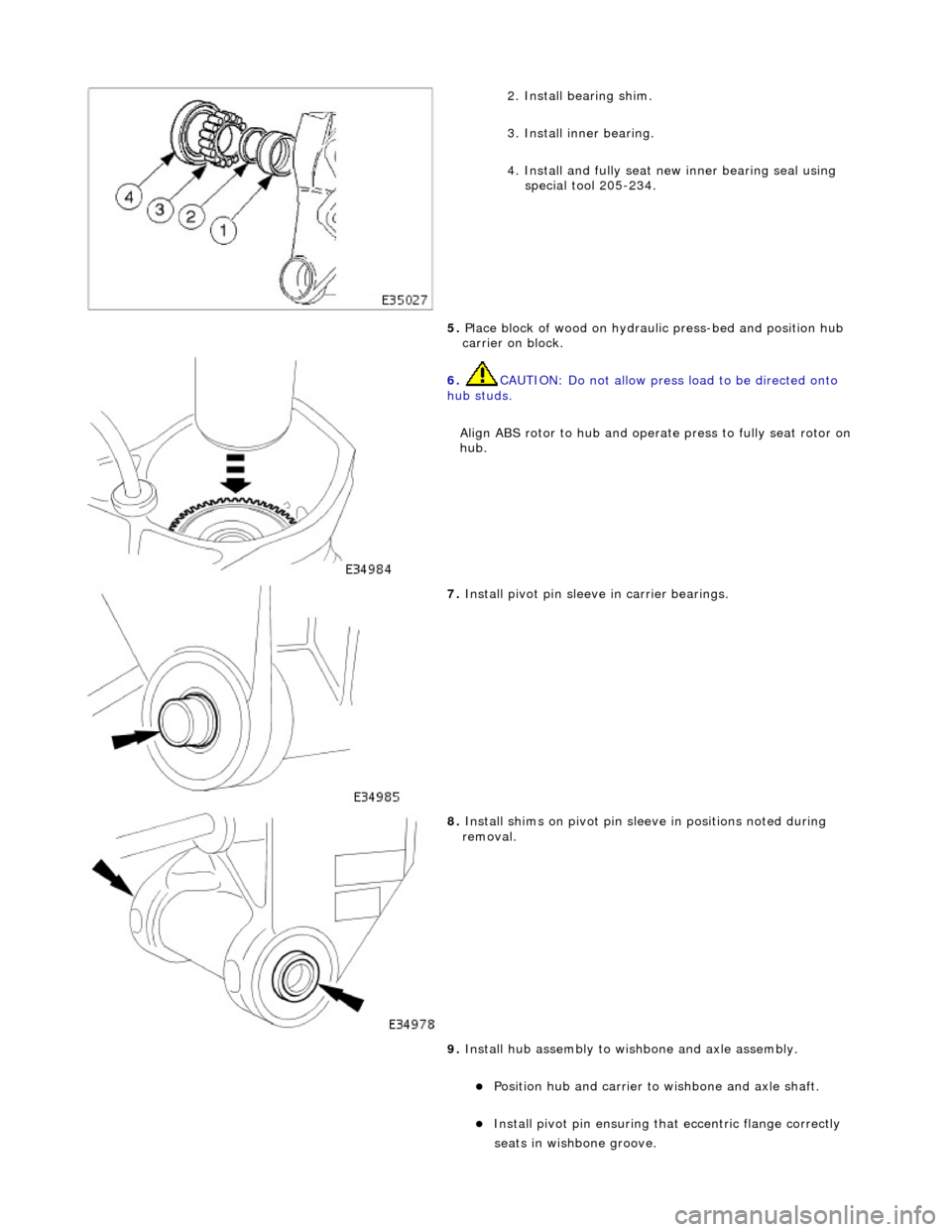
2.
Install bearing shim.
3. Install inner bearing.
4. Install and fully seat new inner bearing seal using special tool 205-234.
5. Place block of wood on hydrau lic press-bed and position hub
carrier on block.
6. CAUTIO
N: Do not allow press
load to be directed onto
hub studs.
Align ABS rotor to hub and operat e press to fully seat rotor on
hub.
7. Install piv o
t pin sleeve in carrier bearings.
8. Inst al
l shims on pivot pin slee
ve in positions noted during
removal.
9. Install hub assembly to wi shbone and axle assembly.
Position hub and carr
ier to wishbone and axle shaft.
Install pivo
t pin ensuring that
eccentric flange correctly
seats i
n wishbone groove.
Page 248 of 2490

Rear Su
spension - Wh
eel Knuckle Bushing
Remo
val and Installation
Remov
a
l
S
p
ecial Tool(s)
Hub Holdin
g Tool
2
04-195 (JD227)
Hub Pu
ller
204-011 (JD 1D)
D rive
r Handle
100-013 (18G-134)
Bearing Cu p Replacer Adaptor
2
04-120 (JD 550-6)
1. CAUTION: Replacement of nuts and bolts: Various
thread-locking devices are used on nuts and bolts throughout the
vehicle. These devices restrict the number of times a nut or bolt
can be used. See section 100-00 for information.
Release parking brake.
2. Ra
ise the vehicle on a four-post lift.
3. Fully slacken bu
t do not remove parking brake cable adjuster
nut.
4. Release appropriate side parkin g brake cable from connecting
Page 262 of 2490

Wheel C
hanging
For wheel
chan
ging proced
ure refer to 74.20.05.
CAUTION: Do not allow grease to contaminate the wheel stud threads and wheel nut to wheel mating surface, as this
may cause the nuts to loosen.
• NOTE: When installing the wheel, smear a thin layer of grease onto the hub mounting face and spigot; and wheel
mounting face and spigot hole, to prev ent the wheel corroding on to the hub.
Locking Wheel Nuts
Locking wheel nuts are fitted as standard to UK vehicles.
1—Stee
l Wheel Trim 7J x 16
2—St
arbur
st Alloy 7J x 16
3—Cro
w
n Alloy 7J x 16
4—Sol
a
r Alloy 7.5J x 17
5—Ce
lt
ic Alloy 8J x 17
6—Lunar All
oy 7J
x 16
7—As
te
roid Alloy 8J x 18
8—Cor
ona Al
loy 7J x 16
9—Ecli
pse Alloy 8J x 16
10—Mi
lan All
oy 8.5J x 18
11—R
K
Winter Wheel 8.5J x 18
It
e
m
Par
t
Number
De
scr
iption
1—Lockin
g whe
el nut
2—Cov
e
r
3—Cov
e
r removal tool
4—Wre
n
ch socket
It
e
m
Par
t
Number
De
scr
iption
Page 263 of 2490
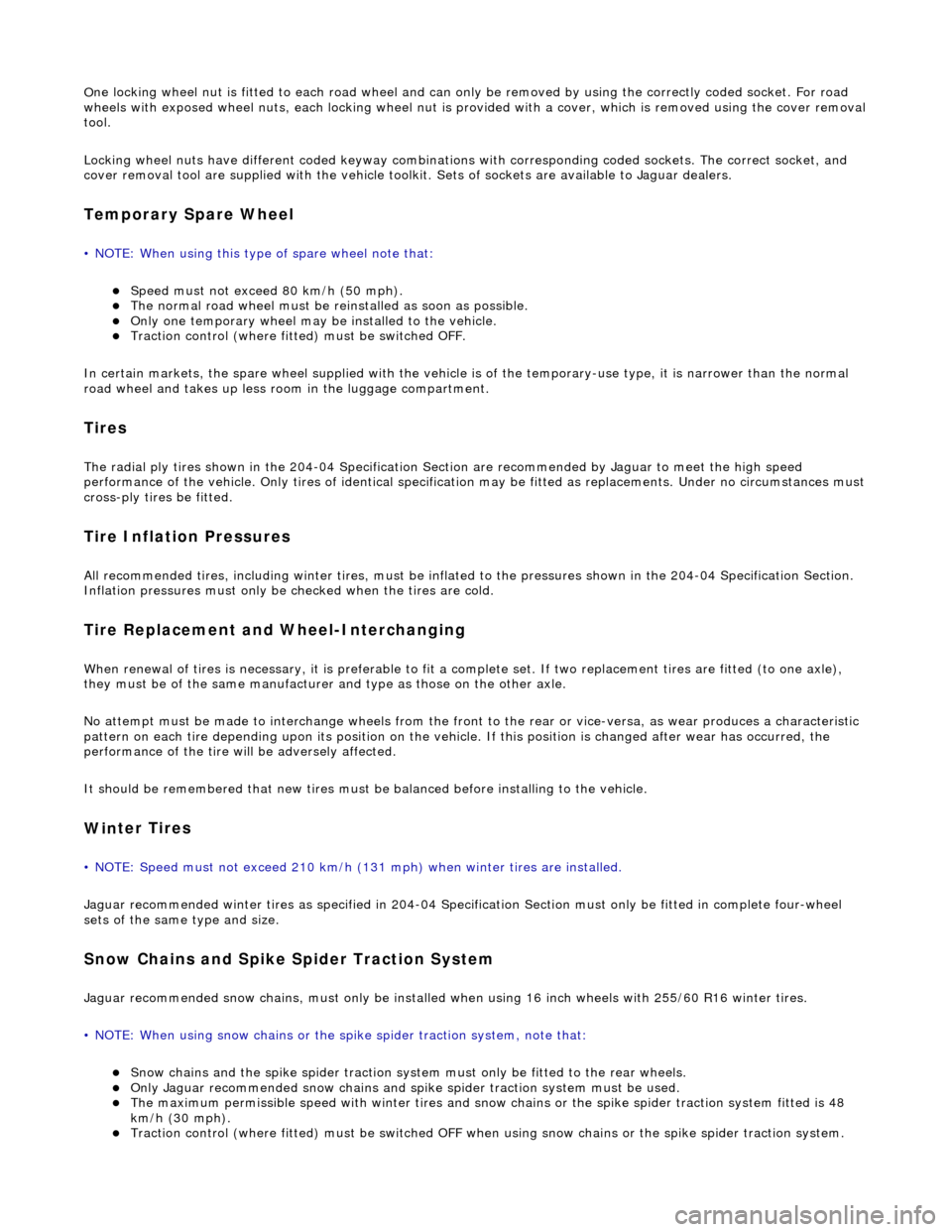
O
ne locking wheel nut is fitted to each road wheel and can on
ly be removed by using the correctly coded socket. For road
wheels with exposed wheel nuts, each locking wheel nut is provided with a cover, which is removed using the cover removal
tool.
Locking wheel nuts have different coded keyway combinations with corresponding coded sockets. The correct socket, and
cover removal tool are supplied with the vehicle toolkit. Sets of sockets are available to Jaguar dealers.
Temporary Spare Wheel
•
NOTE: When using this type of spare wheel note that:
Speed
must not exceed 80 km/h (50 mph).
The normal ro
ad wheel must be reinstalled as soon as possible.
On
ly one temporary wheel may be installed to the vehicle.
Tracti
on control (where fitted
) must be switched OFF.
In certain markets, the spare wheel supplied with the vehicle is of the temporary-use type, it is narrower than the normal
road wheel and takes up less room in the luggage compartment.
Tire
s
The
radial ply tires shown in the 204-04
Specification Section are recommended by Jaguar to meet the high speed
performance of the vehicle. Only tires of identical specification may be fitted as replacements. Unde r no circumstances must
cross-ply tires be fitted.
Tire Inflation Pressures
Al
l recommended tires, including winter tire
s, must be inflated to the pressures shown in the 204-04 Specification Section.
Inflation pressures must only be checked when the tires are cold.
Tire Replac
ement and Wheel-Interchanging
W
hen renewal of tires is necessary, it is
preferable to fit a complete set. If two replacement tires are fitted (to one axle),
they must be of the same manufacturer and type as those on the other axle.
No attempt must be made to interchange wh eels from the front to the rear or vice-versa, as wear produc es a characteristic
pattern on each tire depending upon its po sition on the vehicle. If this position is changed after wear has occurred, the
performance of the tire w ill be adversely affected.
It should be remembered that new tires must be balanced befo re installing to the vehicle.
Win
ter Tires
•
NOTE: Speed must not exceed 210 km/h (131 mph) when winter tires are installed.
Jaguar recommended winter tires as specified in 204-04 Specification Section must only be fitted in complete four-wheel
sets of the same type and size.
Snow Chains and Spike Spider Traction System
Jagu
ar recommended snow chains, must on
ly be installed when using 16 inch wheels with 255/60 R16 winter tires.
• NOTE: When using snow chains or the spike spider traction system, note that:
Snow ch
ains and the spike spider
traction system must only be fitted to the rear wheels.
O
nly Jaguar recommended snow chains and spik
e spider traction system must be used.
The m
aximum permissible speed with winter tires and snow chains or the spike spider traction system fitted is 48
km/h (30 mph).
Tracti
on control (where fitted) must be
switched OFF when using snow chains or the spike spider traction system.
Page 284 of 2490
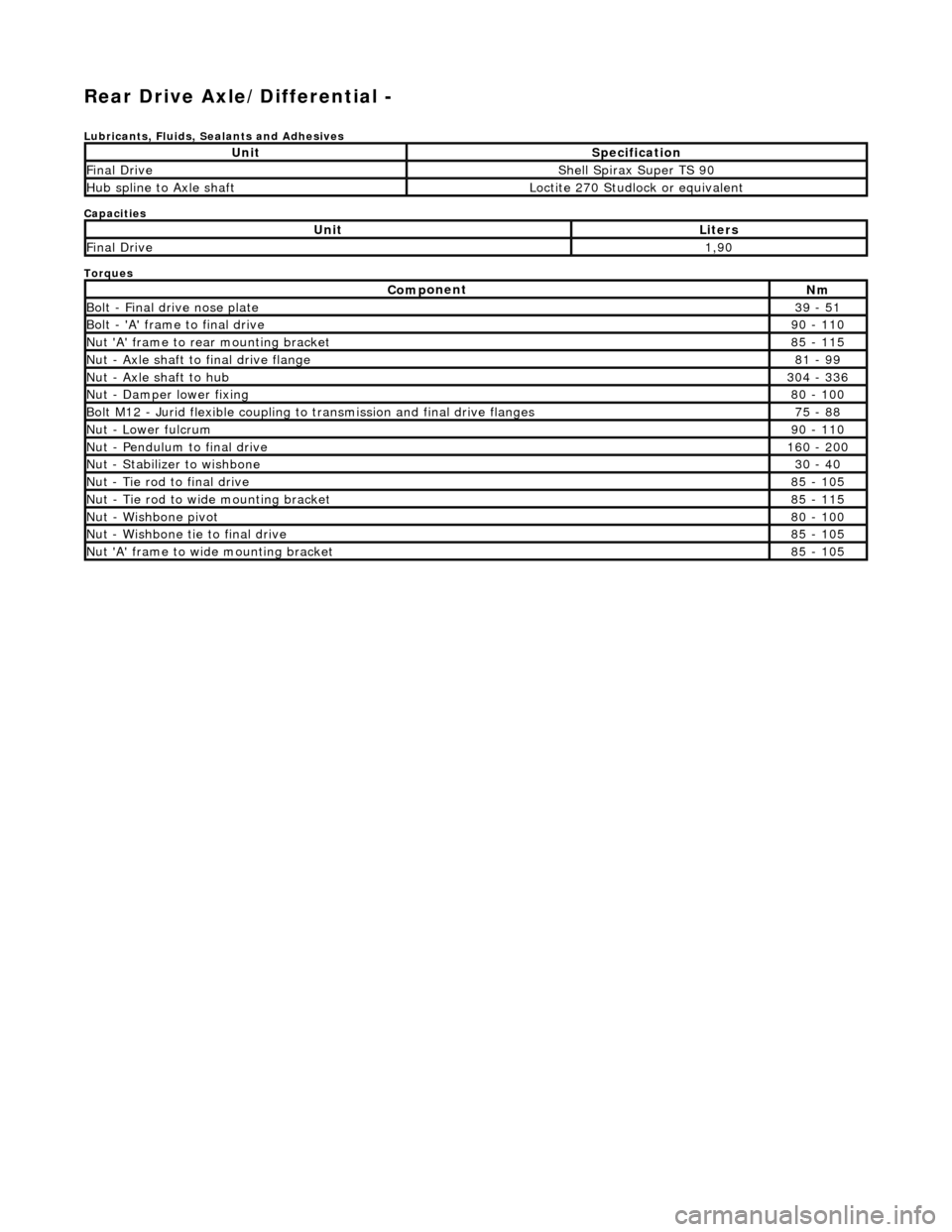
Re
ar Drive Axle/Differential -
Lubric
ants, Fluids, Sealants and Adhesives
Capacities
Torques
UnitSp
ecification
F
i
nal Drive
Shell Sp
irax Supe
r TS 90
Hub s
p
line to Axle shaft
Loct
it
e 270 Studlock or equivalent
UnitLi
t
ers
F
i
nal Drive
1,
90
Com p
onent
Nm
B
ol
t - Final drive nose plate
39
- 51
Bol t
- 'A' frame to final drive
9
0 -
110
Nu
t 'A' f
rame to rear mounting bracket
8
5 -
115
Nu
t -
Axle shaft to final drive flange
81
-
99
Nu
t -
Axle shaft to hub
3
04 -
336
N
u
t - Damper lower fixing
8
0 -
100
Bol
t
M12 - Jurid flexible coupling to
transmission and final drive flanges
75 -
88
N
u
t - Lower fulcrum
9
0 -
110
Nu
t -
Pendulum to final drive
1
60 -
200
N
u
t - Stabilizer to wishbone
30
-
40
N
u
t - Tie rod to final drive
8
5 -
105
Nu
t -
Tie rod to wide mounting bracket
8
5 -
115
Nu
t -
Wishbone pivot
8
0 -
100
N
u
t - Wishbone tie to final drive
8
5 -
105
N
u
t 'A' frame to wide mounting bracket
8
5 -
105
Page 290 of 2490
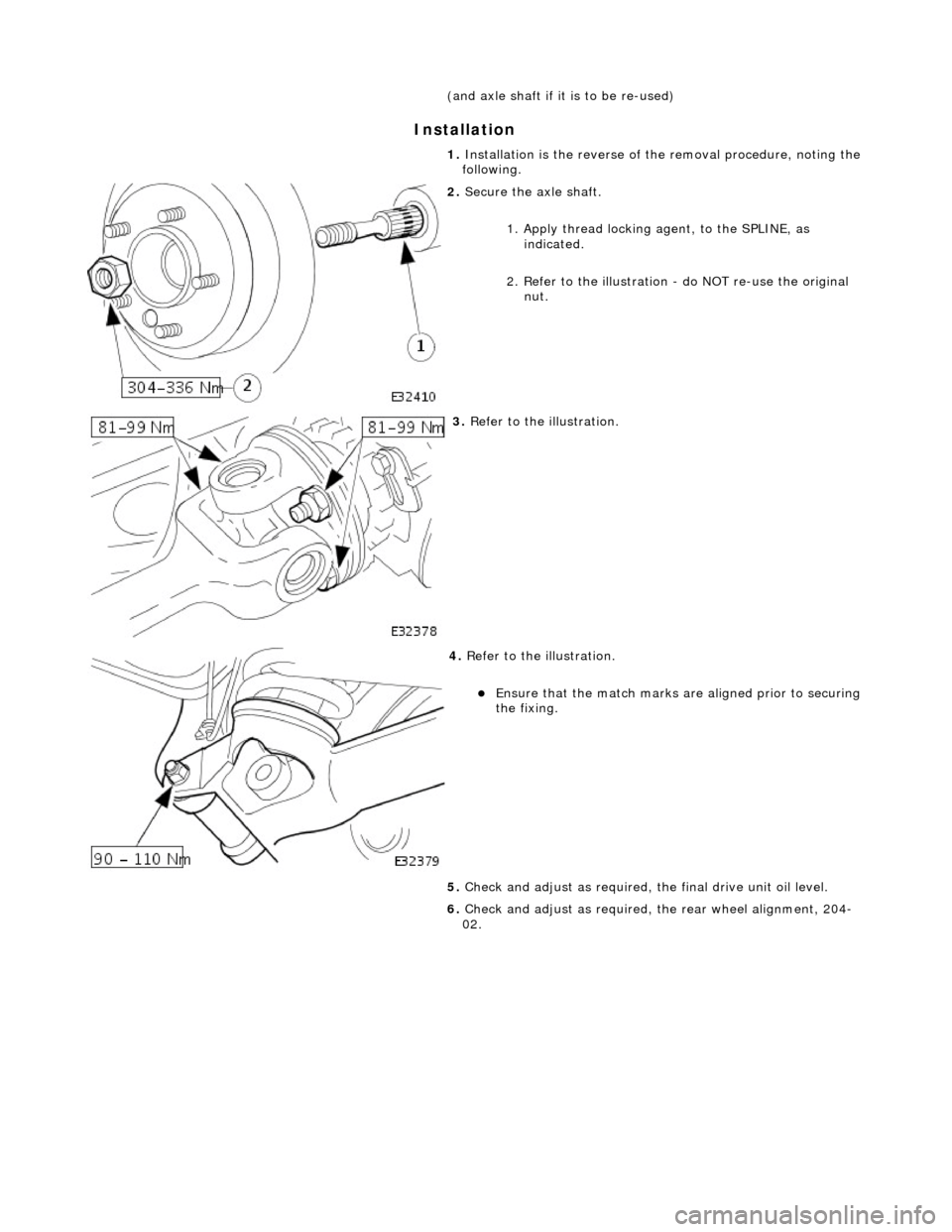
In
stallation
(and axle shaft if i
t
is to be re-used)
1. Installation is the re verse of the removal procedure, noting the
following.
2. Secure the axle shaft.
1.
Apply thread locking agent, to the SPLINE, as
indicated.
2. Refer to the illustration - do NOT re-use the original
nut.
3. Re
fer to the illustration.
4. Re
fer to the illustration.
E
n
sure that the match marks ar
e aligned prior to securing
the fixing.
5. Check and adjust as required, the final drive unit oil level.
6. Check and adjust as required, the rear wheel alignment, 204-
02.
Page 302 of 2490
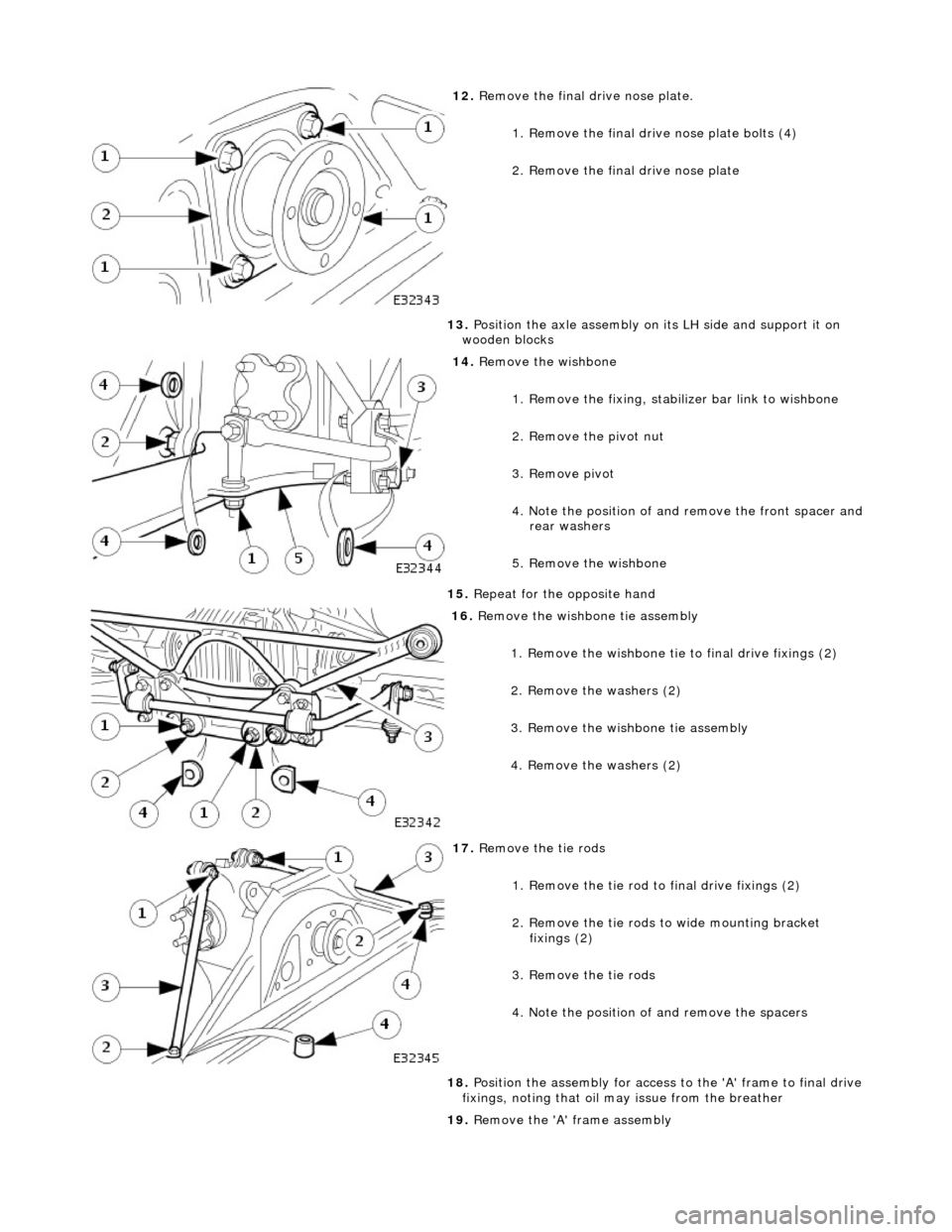
12. R
emove the final dr
ive nose plate.
1. Remove the final drive nose plate bolts (4)
2. Remove the final drive nose plate
13. Position the axle assembly on its LH side and support it on
wooden blocks
14 . Re
move the wishbone
1. Remove the fixing, stabilizer bar link to wishbone
2. Remove the pivot nut
3. Remove pivot
4. Note the position of and remove the front spacer and
rear washers
5. Remove the wishbone
15. Repeat for the opposite hand
16 . R
emove the wishbone tie assembly
1. Remove the wishbone tie to final drive fixings (2)
2. Remove the washers (2)
3. Remove the wishbone tie assembly
4. Remove the washers (2)
17. R
emove the tie rods
1. Remove the tie rod to final drive fixings (2)
2. Remove the tie rods to wide mounting bracket
fixings (2)
3. Remove the tie rods
4. Note the position of and remove the spacers
18. Position the assembly for access to the 'A' frame to final drive
fixings, noting that oil may issue from the breather
19. Remove the 'A' frame assembly
Page 310 of 2490
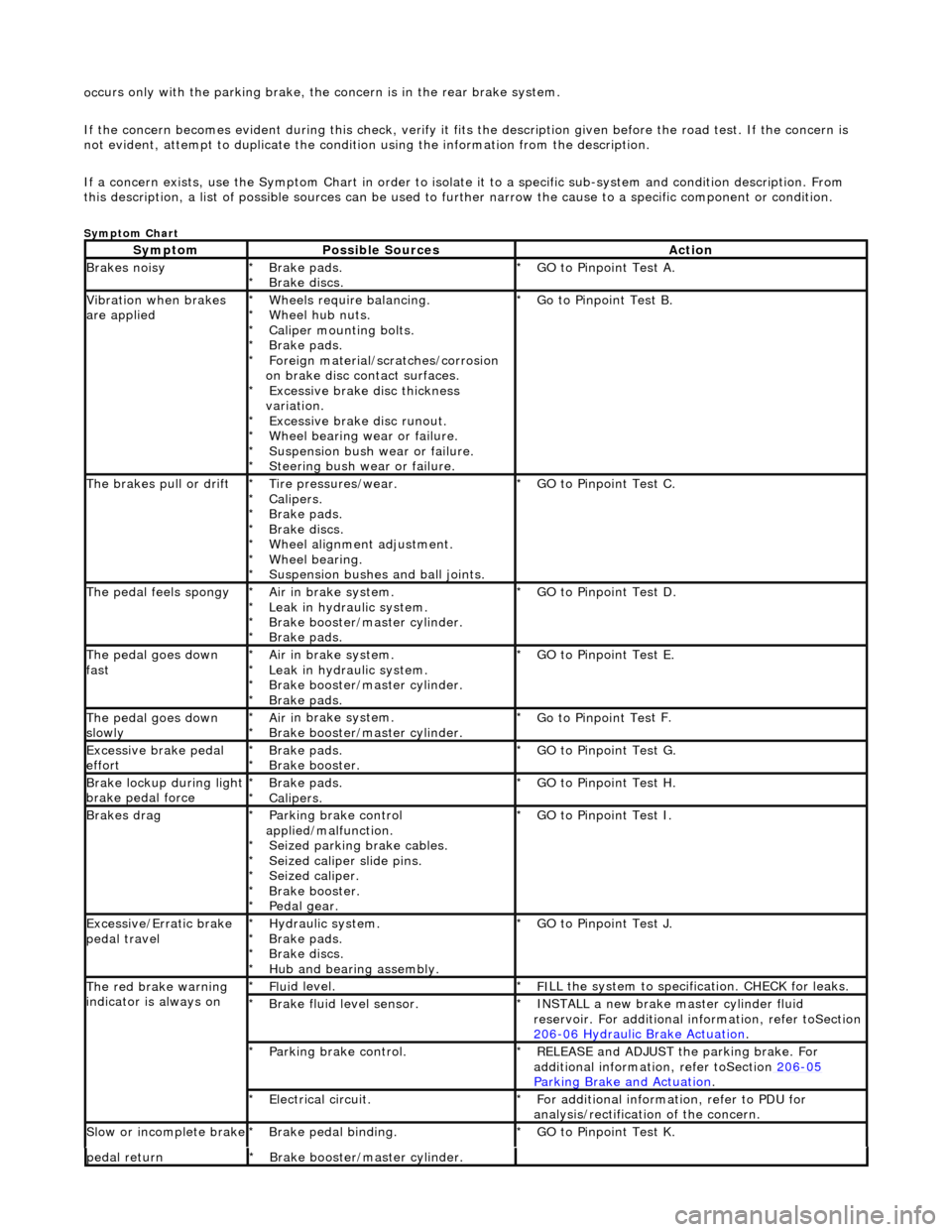
oc
curs only with the parking brake, th
e concern is in the rear brake system.
If the concern becomes evident during this check, verify it fits the description given before the road test. If the concern is
not evident, attempt to duplicate the condition using the information from the description.
If a concern exists, use the Symptom Chart in order to isolate it to a specific sub-system and condition description. From
this description, a list of possible sources can be used to further narrow the cause to a specific component or condition.
Sym
ptom Chart
Sy
m
ptom
Possib
l
e Sources
Acti
o
n
Brakes
n
oisy
Brake pads.
Brake di
scs
.
*
*
GO to Pinpoint
Tes
t A.
*
Vibration wh
en brakes
are applied
Wh eels require bala
ncing.
Wheel hub nuts.
Caliper mounting bolts.
Brake pads.
Foreign material/scr atches/corrosion
on brake disc contact surfaces. Excessive brake disc thickness
variation. Excessive brake disc runout.
Wheel bearing wear or failure.
Suspension bush wear or failure.
Steering bush wear or failure.
*
*
*
*
*
*
*
*
*
*
Go to Pinpoint
Tes
t B.
*
The brakes pull or drif tTire pressures/wear.
Calipers.
Brake pads.
Brake di
scs.
Wheel alignment adjustment.
Wheel bearing.
Suspension bushes and ball joints.
*
*
*
*
*
*
*
GO to Pinpoint
Tes
t C.
*
The pedal feels spongyAir i
n brake system.
Leak in hydraulic system.
Brake booster/master cylinder.
Brake pads.
*
*
*
*
GO to Pinpoint Tes
t D.
*
The pedal goes down
fa s
t
Ai
r i
n brake system.
Leak in hydraulic system.
Brake booster/master cylinder.
Brake pads.
*
*
*
*
GO to Pinpoint
Tes
t E.
*
The pedal goes down
slowl yAir i
n brake system.
Brake booster/master cylinder.
*
*
Go to Pinpoint
Tes
t F.
*
Excessive brake pedal
effor tBrake pads.
Brake booster.
*
*GO to Pinpoint
Tes
t G.
*
Brake lockup du ring ligh
t
brake pedal force
Brake pads.
Calipers.
*
*GO to Pinpoint
Tes
t H.
*
Brakes d r
ag
Parkin
g brake con
trol
applied/malfunction. Seized parking brake cables.
Seized caliper slide pins.
Seized caliper.
Brake booster.
Pedal gear.
*
*
*
*
*
*
GO to Pinpoint
Tes
t I.
*
Exce ssi
ve/Erratic brake
pedal travel
Hydrau li
c system.
Brake pads.
Brake discs.
Hub and bearing assembly.
*
*
*
*
GO to Pinpoint
Tes
t J.
*
The red brak e warning
indi
cator is always on
Fl
ui
d level.
*
F I
LL the system to specification. CHECK for leaks.
*
Brake flu i
d level sensor.
*
I N
STALL a new brake master cylinder fluid
reservoir. For additional in formation, refer toSection
206
-0 6
Hydraulic Brake Actuation
.
*
Parkin
g brake con
trol.
*
REL
E
ASE and ADJUST the parking brake. For
additional information, refer toSection 206
-05
Parkin g Brake an
d Actuation
.
*
E
l
ectrical circuit.
*
F or additional
information, refer to PDU for
analysis/rectification of the concern.
*
Sl
ow or i
ncomplete brake
Brake peda
l binding.
*
GO to Pinpoint Tes
t K.
*
pedal retu rnBr
ake booster/master cylinder.
*
Page 315 of 2490
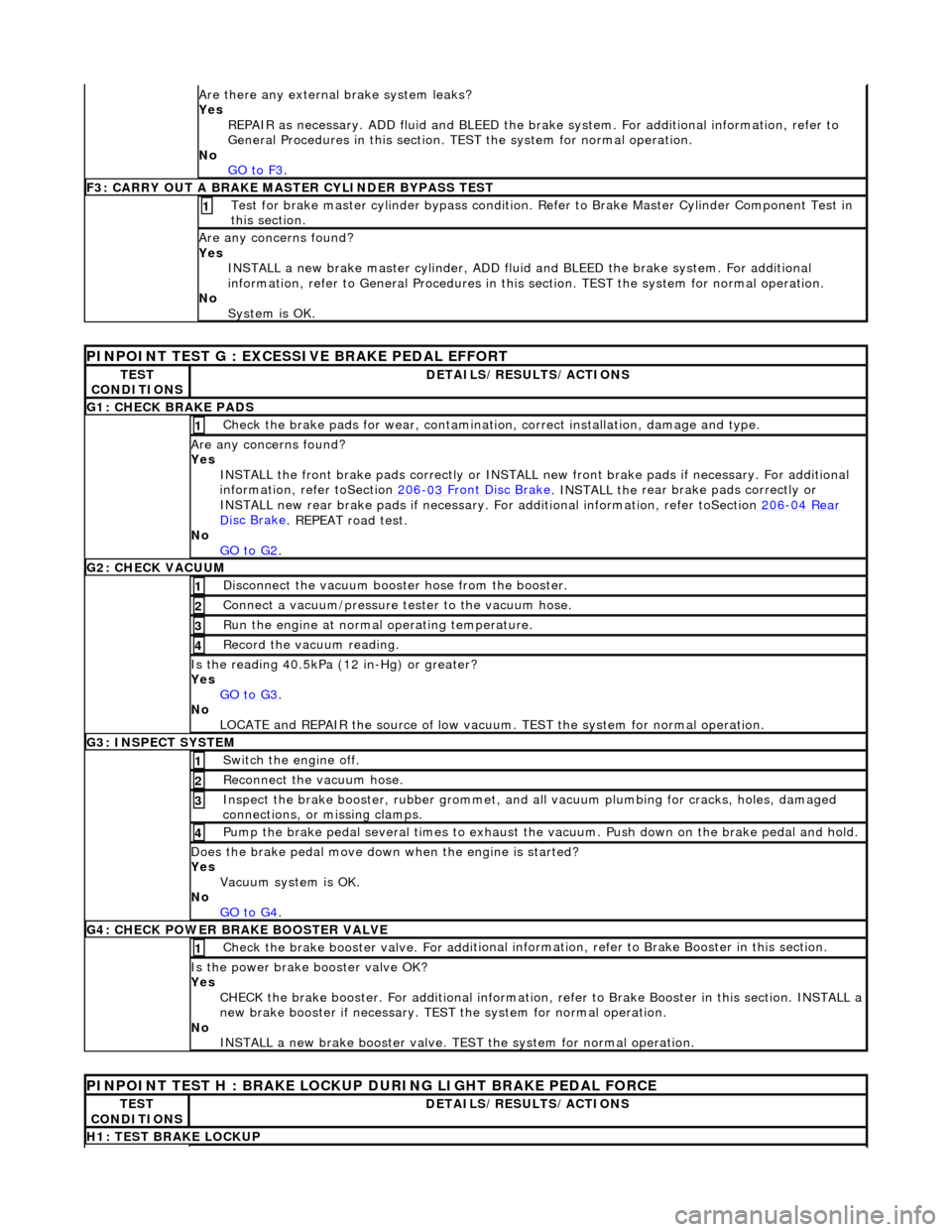
Are th
ere any external brake system leaks?
Yes REPAIR as necessary. ADD fluid and BLEED the brak e system. For additional information, refer to
General Procedures in this section. TEST the system for normal operation.
No GO to F3
.
F
3: CARRY OUT A BRAKE MASTER CYLINDER BYPASS TEST
Te
st for brake master cylinder bypass condition. Re
fer to Brake Master Cylinder Component Test in
this section.
1
A
re any concerns found?
Yes INSTALL a new brake master cylinder, ADD flui d and BLEED the brake system. For additional
information, refer to General Proc edures in this section. TEST the system for normal operation.
No System is OK.
PINPO
INT TEST G : EXCESSIVE BRAKE PEDAL EFFORT
TE
ST
CONDITIONS
D
ETAILS/RESULTS/ACTIONS
G1
: CHECK BRAKE PADS
Check the brake pads for wear, contamin
atio
n, correct installation, damage and type.
1
A
re any concerns found?
Yes INSTALL the front brake pads correctly or INSTALL ne w front brake pads if necessary. For additional
information, refer toSection 206
-03
Front Disc Brake
. INSTALL the
rear brake pads correctly or
INSTALL new rear brake pads if necessary. For additional information, refer toSection 206
-04
Rear
Di
sc Brake
. REPEAT road test.
No
GO to G2
.
G2:
CHECK VACUUM
Di
sconnect the vacuum booster hose from the booster.
1
Conne
ct a vacuum/pressure tester to the vacuum hose.
2
Ru
n the engine at normal operating temperature.
3
Re
cord the vacuum reading.
4
Is
the reading 40.5kPa (1
2 in-Hg) or greater?
Yes GO to G3
.
No
LOCATE and REPAIR the source of low vacuum . TEST the system for normal operation.
G3
: INSPECT SYSTEM
Swi
tch the engine off.
1
Re
connect the vacuum hose.
2
Inspect th
e brake booster, rubber grommet, and al
l vacuum plumbing for cracks, holes, damaged
connections, or missing clamps.
3
Pump th
e brake pedal several time
s to exhaust the vacuum. Push down on the brake pedal and hold.
4
Does th
e brake pedal move down
when the engine is started?
Yes Vacuum system is OK.
No GO to G4
.
G4
: CHECK POWER BRAKE BOOSTER VALVE
Check the brake booster valve. For
add
itional information, refer to
Brake Booster in this section.
1
Is th
e power brake booster valve OK?
Yes CHECK the brake booster. Fo r additional information, refer to Brak e Booster in this section. INSTALL a
new brake booster if necessary. TEST the system for normal operation.
No INSTALL a new brake booster valve. TEST the system for normal operation.
P
INPOINT TEST H : BRAKE LOCKUP
DURING LIGHT BRAKE PEDAL FORCE
TE
ST
CONDITIONS
D
ETAILS/RESULTS/ACTIONS
H1
: TEST BRAKE LOCKUP
Page 316 of 2490
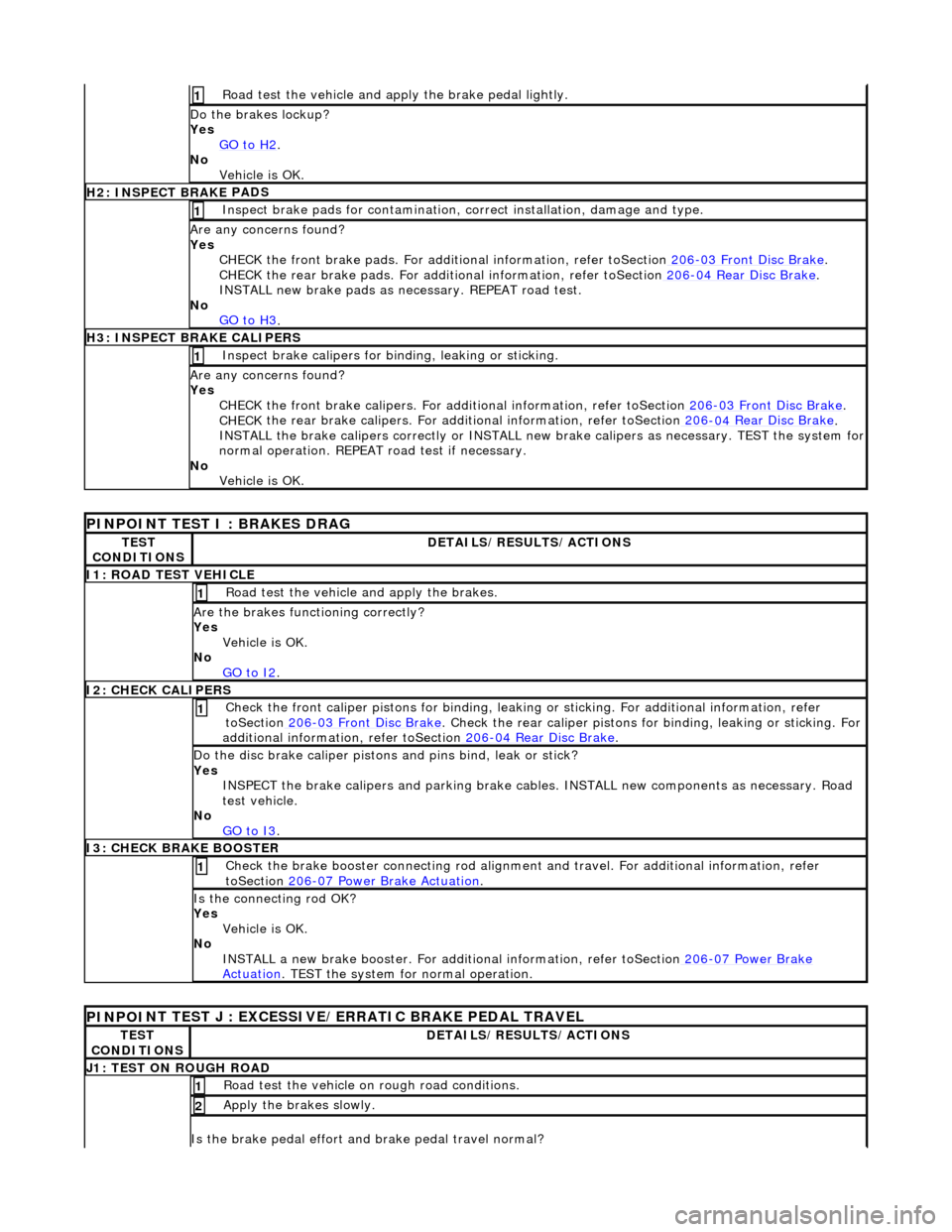
Road test the veh
icle and a
pply the brake pe dal lightly.
1
Do th
e brakes lockup?
Yes GO to H2
.
No
Vehicle is OK.
H2: INSPECT BRAKE PADS
Inspect brake pads for con
t
amination,
correct installation , damage and type.
1
Ar
e any concerns found?
Yes CHECK the front brake pads. For additi onal information, refer toSection 206
-03 Fr
ont Disc Brake
.
CHECK
the rear brake pads. For additi
onal information, refer toSection 206
-04
Rear Disc Brake
.
INST ALL new brake pads as ne ce
ssary. REPEAT
road test.
No GO to H3
.
H3: INSPECT BRAKE CALI
PERS
Inspect brake cali
pers for bindi
ng, leaking or sticking.
1
A
r
e any concerns found?
Yes CHECK the front brake calipers. For addi tional information, refer toSection 206
-03 Fr
ont Disc Brake
.
CHECK
the rear brake calipers. For addi
tional information, refer toSection 206
-04
Rear Disc Brake
.
IN ST
ALL the brake calipers correctly or INSTALL new
brake calipers as necessary. TEST the system for
normal operation. REPEAT road test if necessary.
No Vehicle is OK.
PI
NPOINT TEST I : BRAKES DRAG
TE
S
T
CONDITIONS
D E
TAILS/RESULTS/ACTIONS
I1
:
ROAD TEST VEHICLE
Ro
ad t
est the vehicle
and apply the brakes.
1
Are the brakes
functioning correctly?
Yes Vehicle is OK.
No GO to I2
.
I2
: CHECK CALIPERS
Check the fr
on
t caliper pistons for binding, leakin
g or sticking. For additional information, refer
toSection 206
-03 Fr
ont Disc Brake
. Check the rear cal
i
per pistons for
binding, leaking or sticking. For
additional information, refer toSection 206
-04
Rear Disc Brake
.
1
Do t
h
e disc brake caliper pistons
and pins bind, leak or stick?
Yes INSPECT the brake calipers and pa rking brake cables. INSTALL new co mponents as necessary. Road
test vehicle.
No GO to I3
.
I3
: CHECK BRAKE BOOSTER
Check the brake booster con
n
ecting rod alignment
and travel. For additional information, refer
toSection 206
-0 7
Power Brake Actuation
. 1
Is the co
nnecti
ng rod OK?
Yes Vehicle is OK.
No INSTALL a new brake booster. For addi tional information, refer toSection 206
-07
Power Brake
Actuation. TEST
the system for
normal operation.
PINPO
I
NT TEST J : EXCESSIVE/ERRATIC BRAKE PEDAL TRAVEL
TE
S
T
CONDITIONS
D E
TAILS/RESULTS/ACTIONS
J
1
: TEST ON ROUGH ROAD
R
oad test the vehi
cle on rough road conditions.
1
Apply the brakes slowly. 2
Is th
e brake pedal ef
fort an
d brake pedal travel normal?